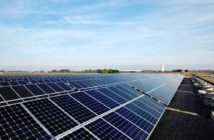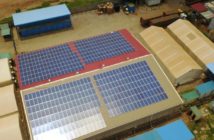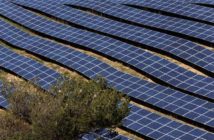Morocco is set to pay more for its solar power than far richer countries such as Germany and should switch tack to cheaper solar technologies that can compete better with wind, oil and coal.
The higher cost can probably be attributed to its choice of concentrated solar power (CSP), the competitiveness of which is being questioned as prices of rival photovoltaic (PV) technology tumble.
Morocco plans to install at least 2,000 megawatts (MW) of solar power capacity by 2020 at five sites, which it hopes will account for 14 percent of total power generating capacity by the end of the decade.
It will target both CSP and solar PV in its Moroccan Plan for Solar Energy, or “Solar Plan”, according to the Moroccan Investment Development Agency, but has so far veered towards more expensive CSP at one initial project near the southern city of Ouarzazate.
That contrasts with how developers in California have increasingly ditched CSP for PV over the past three years as a global manufacturing glut sent PV costs plummeting.
CSP uses parabolic or other types of mirrors to concentrate sunlight and create heat and steam to drive a turbine. It is a technology championed by power equipment producers in Spain, Morocco’s neighbour and one of its closest diplomatic allies.
Solar PV converts sunlight directly into electricity using a light-sensitive semiconductor such as silicon.
Morocco would do well to switch to PV, given a far more developed supply chain, commoditised end product and competitive power generation, especially given that the country’s economic troubles make it riskier to experiment with less widely used technologies.
POWER PURCHASE
Moroccan authorities anticipated the solar plan would cost $9 billion at its launch in 2009, according to data on the website of the north African country’s solar energy agency, Masen.
The plan will be part-financed by a $1 billion Energy Development Fund, including donations from the Kingdom of Saudi Arabia and the United Arab Emirates.
Morocco has raised additional funds for the first Ouarzazate project from institutions including the European Investment Bank, the French Development Agency (AFD) and the German development bank KfW.
The plan will be delivered through 25-year power purchase agreements (PPA) with independent power producers which earn a fixed rate per unit of solar power they generate.
The aim is to achieve greater energy independence: Morocco is one of the world’s most energy-poor countries, importing around 95 percent of its needs, according to the World Bank.
Energy accounts for more than a quarter of the country’s imports and contributed to a record trade deficit of $23.6 billion last year.
SUNNY
Sun-drenched Morocco wants eventually to export its solar energy to Europe.
The U.S. National Renewable Energy Laboratory (NREL) has developed an open-access database measuring solar irradiance calculated according to the sunlight captured by a panel tilted southwards, defined in units of kilowatt hours per square metre per day.
The NREL’s map shows a maximum “Direct Normal Irradiance” (DNI) in southwest Germany of 3.39, compared with 7.47 at Ouarzazate in Morocco. (See Chart 1)
It shows that the Moroccan project should achieve far more competitive power generation.
But Morocco announced last September that it had awarded a group led by Saudi International Company for Water and Power (ACWA) a $1 billion contract to build a 160-megawatt (MW) CSP plant, at 1.62 dirham ($0.194) per kilowatt hour.
ACWA last week confirmed further details including the award of construction contracts.
That is more support than for smaller PV installations in Germany, at 0.134 euros ($0.18) per kWh for projects up to 10 MW, and in Britain, at 0.115 pounds ($0.18) for projects above 250 kilowatts, both of which are over 20 rather than 25 years.
Germany has scrapped support for projects over 10 MW.
*************************************
Chart 1: http://goo.gl/Kks9E
Chart 2: (page 4) http://goo.gl/EA54k
*************************************
CSP VS PV
One way to compare costs of PV relative to CSP is using a measure called levelised cost of energy (LCOE), based on total lifetime costs and energy generation.
Germany’s Fraunhofer Institute last year published a detailed LCOE study including a comparison of CSP and PV costs in North Africa, where its central estimate for CSP at 0.163 euros ($0.21) closely matched the contract subsequently agreed in Morocco.
The Fraunhofer analysis found that CSP was almost twice as expensive as solar PV and three times more so than wind, and forecast it would remain far more costly than PV through 2030. (Chart 2)
“A considerable reduction in costs in recent years has given PV installations a cost advantage over CSP plants at the same location,” it concluded.
Masen is aiming to install some 500 MW capacity at its Ouarzazate site, and to start commissioning this by 2015.
The project will be delivered in three parts: an initial 160 MW of CSP using conventional parabolic mirrors (the contract now awarded), and two subsequent phases for 300 MW of CSP including a project using innovative solar tower technology which is even more expensive.
That appears to leave less than 50 MW for solar PV.
The main advantage of CSP is its ability to control when the energy is released for consumption.
The first contracted CSP plant at Ouarzazate in Morocco will provide three hours of storage, according to a press release published by MASEN on Jan. 23, meaning it can tweak output to match consumer demand like a conventional power plant.
PV electricity must be consumed at the instant of generation unless the grid has some kind of storage such as pumped hydropower.
But the ability to store solar power, known as dispatchability, is hardly a priority at this early stage when Morocco’s grid is dominated by dispatchable coal and oil-fired power.
Masen’s plan to export some of its solar power to Europe via Spain to help plug the trade deficit appears far-fetched given how expensive it will be to produce.
At the agreed price, the solar power may also be a drain on the Moroccan budget if the government has to cover any gap between the cost of producing solar electricity and the price the state power utility will pay. ($1 = 0.7642 euros) ($1 = 0.6464 British pounds) (Reporting by Gerard Wynn; Editing by Tom Pfeiffer)






